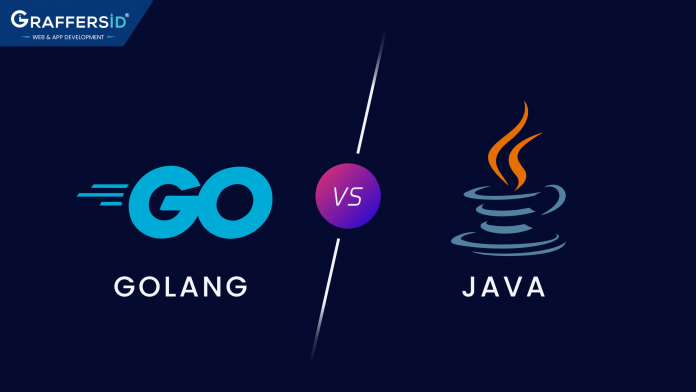Are you trying to look for the best programming language for your next development project? Yes, then you have landed on the right page. Java and Golang are the most popular languages for developing scalable and efficient web, server, and mobile applications. However, choosing among both is a challenge. Both have unique features, services, and specific needs for each project. Thus, we are comparing Golang with jav to help you determine the best programming language to develop software. This blog will cover an overview of both backend technologies and in-depth differences between Java and Golang jav. Let’s dive into and see how they stack up against each other.
Java v/s Golang: A Quick Overview
Java and Golang are the perfect examples of a new v/s classic object-oriented programming language.
Java
Java is a programming language used to build web applications, mobile applications, and software. Since 1995, Java has been on the list of developers due to its portability and scalability. It designs to run anywhere and for various operating systems and hardware architectures. Java uses its Java Virtual Machines for interpreting and compiling code.
Also, Java’s “write once and run it anywhere” (WORA) has become popular among experts. Additionally, Java uses for developing frameworks, software tools, and libraries that allows developers to build software more efficiently.
Golang
Golang, also known as go, is an open-source programming language released in 2009 by Google. It becomes the center of attention because of its readability and concurrent nature, allowing you to run multiple tasks simultaneously.Go is used for server-side/backend programming and is famous for making command-line tools. It has a static typing feature that allows developers to create maintainable and testable codes in real time. If you want to create high-quality applications tailored to your specific requirements, hire golang developers to make that possible.
Similarities Between Go and Java
Java vs Go for the back end have a large and active developer community. Both object-oriented programs allow you to focus on coding without worrying about memory management, modify smoothly, and optimize code based on specific requirements. Additionally, both languages are cross-platform compatible and run on multiple operating platforms, such as Windows, iOS, and Linux. Now, let’s look at the critical differences between Golang and Java.
7 Differences between Golang and Java
Here are the critical differences between Golang and Java.
1. Golang vs Java Performance
Golang has high-performance capabilities because of its built-in concurrency features, such as Goroutines and channels. At the same time, Java has an extensive ecosystem and supports multithreading. Comparing Golang with Java in optimizing performance, Golang surpasses Java due to its lightweight threading to build scalable web and mobile applications.
2. Golang vs Java for Microservices
Golang’s simple and built-in concurrency features suit developing small and independent services well. In comparison, Java’s extensive ecosystem of libraries and frameworks widely uses for building large and complex applications. Thus, Golang is a popular choice for microservices because of its fast compliant speed, scalability, and reliability compared to Java.
3. Go vs Java Syntax
Comparing Golang with Java, Golang syntax is more precise and easy to read than Java. Golang emphasizes using small, focused functions and minimalist control structures to build applications. In contrast, jav syntax is object-oriented, focusing on the interface and many keywords. It makes Java a powerful language with well-structured code.
4. Java vs Golang for Memory Management
Both Java and Golang have garbage collection that affects memory and performance. Java’s automatic memory management through garbage collection makes it easier for developers to write code without worrying about memory management. Meanwhile, Golang has a hybrid approach and retains fine-grained control over memory allocation and deallocation. Also, the memory usage of Golang is 0.86 MB, and Java is 160 MB, which indicates Golang is better than jav in use.
5. Java vs Golang Platform Support
Java has powerful cross-platform support, whereas Golang’s cross-platform support is still developing. Additionally, Java has a massive ecosystem of libraries and tools available on multiple platforms. While Golang has an ecosystem, it is still growing and needs to be more extensive than jav.
6. Golang vs Java Popularity
Developers have used Java for almost a decade, so there is no second guess about its popularity. However, Golang is no less preferable because of its innovative and straightforward use. Jav has a larger community where Go is still growing and contributing its output.
7. Java vs Go Error Handling
Java uses exceptions to handle errors, which makes code difficult to read and understand. Go uses a built-in error type that makes error messages easy to read and understand. In Golang, error handling is done using return values, with functions returning an error value if something goes wrong. In Java, expectations provide separate error-handling code that simplifies read and write operations.
Final Verdict
Which one is better: Java or Golang? Both are well-suited and perfect for developing software. Ultimately, the choice between Java vs Go for the backend must determine the application’s requirements, development expertise, and project needs. Depending on the specific project requirements, it may be best to hire dedicated Java developer or a Golang jav developer with experience in the relevant areas.Author Bio:
Chandresh Patel is a CEO, Agile coach and founder of Bacancy Technology. His truly entrepreneurial spirit, skillful expertise and extensive knowledge in the Agile software development services has helped the organization to achieve new heights of success. Chandresh is fronting the organization into global markets in a systematic, innovative and collaborative way to fulfill custom software development.



